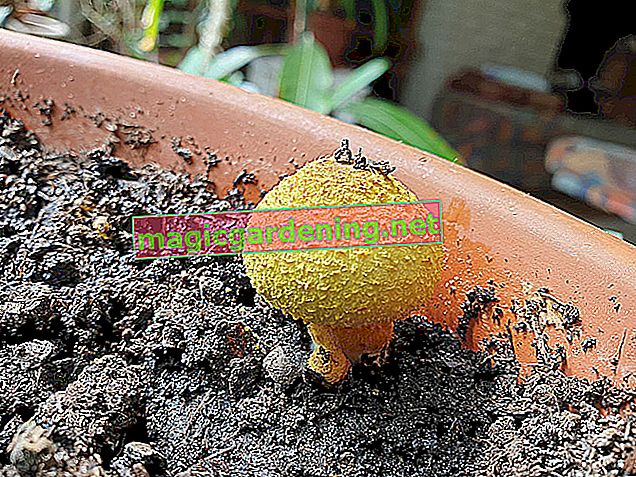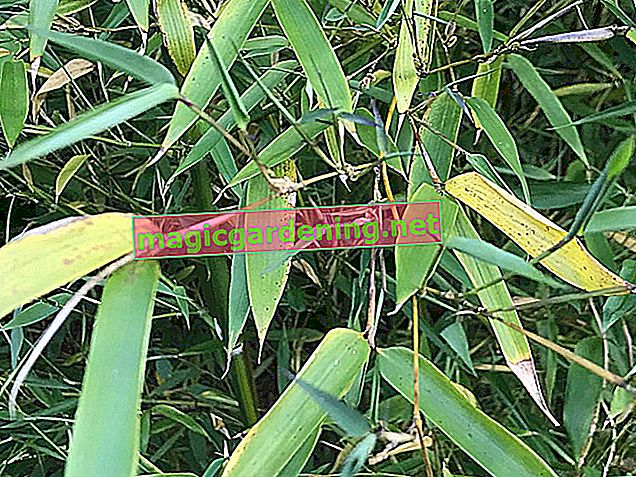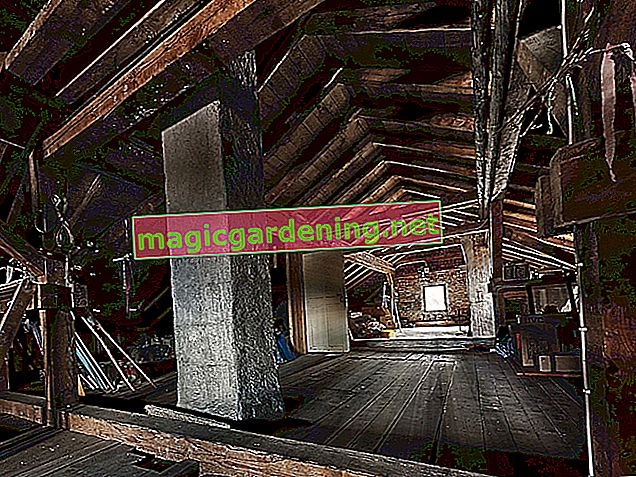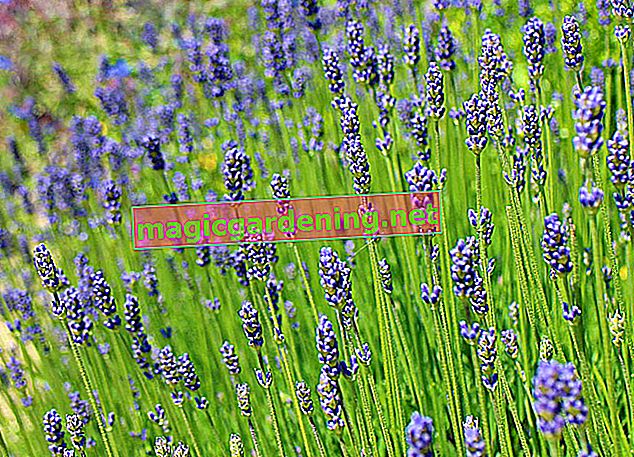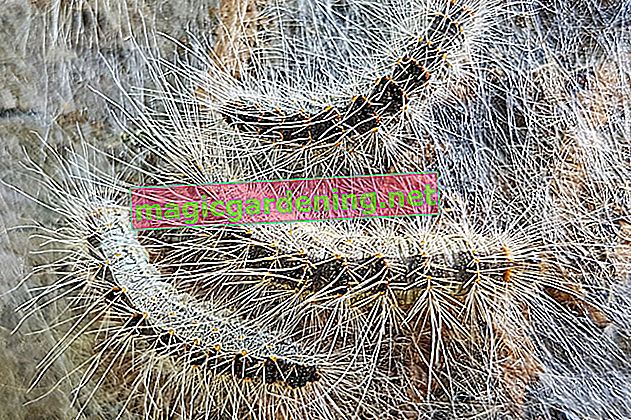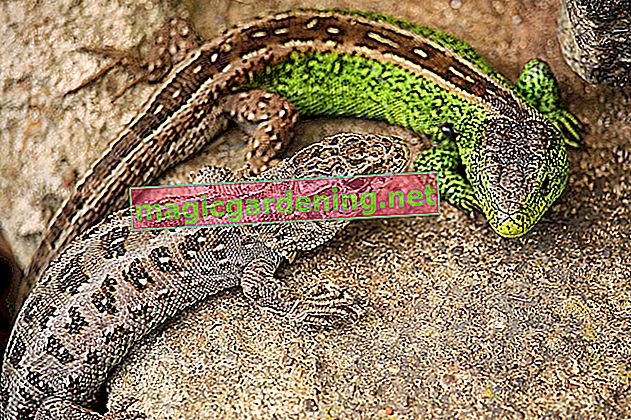
the essentials in brief
- There are around 27,000 scarab beetle species worldwide
- The scarab beetles nibble on the roots of plants while the adult beetles feast on the leaves
- Scarab beetles are best combated by nematodes or with the help of predators
- It is even better to prevent an infestation by regular chopping, root protection mats or insect nets
How to spot a scarab beetle in time
White grubs do not eat plant roots for years, but instead feed on humus. Only from the second year onwards do the larvae feast on the fine roots (and, depending on the species, also on other plant residues) in order to dig up to 60 centimeters deep into the ground and pupate. They remain in this state for another one to two years. While the adult beetles can be spotted quite quickly - and eggs are likely to lay - the grubs are often only discovered by chance.
also read
- Should you fight rose chafer grubs?
- Use nematodes against grubs
- Leaf bug: types, characteristics and means of control
The plants on the infested areas seem to die without any cause. If you can rule out other reasons, the grub infestation can be substantiated quite well with a test excavation on the affected area: The yellowish-white larvae are in the excavation. By the way, you don't have to dig particularly deep, because the animals are only a few centimeters below the surface of the earth.

Prevention is better than fighting
You can prevent an infestation with scarab beetles and their larvae with a few specific measures. However, these methods are not 100% safe. The most important thing is not to leave any lights on in the garden during the main flight time of the various species: the animals, which are usually active at night or at dusk, are attracted to it and prefer to lay their eggs near the light sources. Other useful ways of prevention are:
- Insect protection nets : especially on compost and manure heaps as well as on open ground
- Root guard: protect the rhizomes of plants from the larvae
- Lawn curbs : the beds are surrounded by deep curb stones, the grubs cannot get through here
- Soil work : hoeing, raking, pulling weeds and regular digging of the soil in spring or autumn bothers and harms the grubs
Tips
To protect lawns from death caused by grubs, you should scarify the sward regularly. If that doesn't help either, you should remove the dead lawn, dig up the area deeply and sow again.
Fight scarab beetles effectively
“Collect the cockchafer and tear off their legs and wings. Then toast them in hot butter until they are crispy. Then cook them in chicken soup. " (Centuries old recipe for cockchafer soup)
If the damage is already visible, the plants that have been eaten by grubs cannot be helped. Since the larvae eat the underground roots, the above-ground parts of the plant can no longer be supplied and dry up. In addition, cockchafer larvae occur in abundance - wherever you find a maggot, there are certainly many others in the ground. So it's no wonder that the previous numerous populations were collected and processed into a nutritious cockchafer soup - perhaps your grandparents still know this.
The following options are available in the garden for effective control.
Collecting
In earlier times, one of the main occupations of children during the summer months was collecting cockchafer and their larvae. Even today, the method is effective for the hobby garden, even if it is laborious and time-consuming. The easiest way to collect the grubs is after a heavy downpour, because then the animals come to the surface and can be easily picked up. Such rain can be imitated artificially by vigorously watering the infested areas.
Alternatively, you can simply dig up the soil interspersed with white grubs and thereby bring the larvae to light. This method also has the advantage that the soil is loosened and weeds are removed.
Fight biologically with nematodes
Nematodes are available on the market especially against the larvae of May or June beetles, which reliably kill the pests. These are microscopic roundworms that are delivered in clay granules. Simply mix the granules with the irrigation water and water the affected areas in the garden extensively. The roundworms become active in the soil, penetrate the grubs and kill them.
Natural enemies

One of the best ways to get rid of pesky grubs is to make the garden inviting to hedgehogs, moles, bats, and birds. The fat maggots and the adult beetles like to eat them and thus keep the population low in a natural way. Mice, martens and large ground beetles also like to eat grubs. So that the beneficial insects feel good, install
- corresponding roosts (bird houses, bat boxes, brushwood piles)
- Watering stations and feeding stations with a few delicacies (birds feed in winter!)
- Planting forage and protection plants, for example dense hedges
If you are also the happy owner of a flock of chickens, you can let them run over fallow beds in spring and autumn and across meadows and lawns all year round. The animals specifically peck the grubs out of the ground.
Insecticides against scarab beetles?
Some pesticides are approved for the home and hobby garden as well as for the lawn, which reliably remove the grubs. These include, for example, products made from the seeds of the neem tree native to India, the toxic ingredients of which prevent the larvae from developing. However, you should not use insecticides if possible, as these - regardless of whether they are chemical or natural agents such as neem oil - always have serious effects on the entire ecosystem in the garden and thus also beneficial animals.
Just because a product bears the label “natural” does not mean that it is safe. After all, nature itself produces the most harmful poisons and is therefore anything but “gentle”.
What are scarab beetles?
The scarab beetles (lat. Scarabaeidae) are a very large and complex family within the order of the beetles (lat. Coleoptera). Around 27,000 different species in around 1,600 genera belong to the beetle family found worldwide, which look very different on the outside and can range from a tiny two millimeters to a strikingly large 16 centimeters in length. Not all species pose a problem in the hobby garden, some - such as the rhinoceros beetle, which is threatened with extinction and therefore under nature protection - are also considered beneficial insects.
species
Typical species of scarab beetles that are relevant for the garden are the following:
- June beetle : also ribbed curl beetle, Latin Amphimallon solstitiale
- Common cockchafer : also field cockchafer , Latin Melolontha melolontha
- Shiny gold rose beetle : also common rose beetle, Latin Cetonia aurata
- Rhinoceros beetle : Latin Oryctes nasicornis, feeds on dead wood and is therefore often found in bark mulch
- Garden beetle : Latin Phyllopertha horticola, are often confused with the June beetle, but cause little damage
For many centuries, the cockchafer in particular was decried as a pest and every year, the immense feeding activity of its grubs could cause considerable damage - and thus also famine. Nowadays the cockchafer has become rather rare due to drastic measures, mainly in the 1950s and 1960s, but still causes great damage in warm years and in certain regions. The following video shows the newly emerged problem quite impressively:
YoutubeTypical appearance of the scarab beetle
The scarab beetles mentioned above look very similar, so that mix-ups cannot be ruled out. However, an exact determination of the species that occurs in the garden is important, because otherwise the control measures could fail - not every small beetle reacts as desired to the eradication methods introduced. For this reason you will find some relevant clues for the exact identification of the species in the following table:
| Cockchafer | June beetle | Shiny gold rose beetle | Garden beetle | Rhinoceros beetle | |
|---|---|---|---|---|---|
| Occurrence | almost all of Europe, rare in the Mediterranean | Northern and Central Europe outside the mountains | Europe and Asia, especially Central and Northern Europe | all of Europe and Asia | Europe, Asia, Africa |
| habitat | open landscapes with few trees | Fields, gardens, forest edges, parks | Hedges, gardens, forest edges, parks | in meadows, fields, on the edges of forests, in gardens and hedges | especially in forests, also in tree-lined gardens and parks, compost heaps |
| frequency | now more often again | locally dependent, often to rarely | locally dependent, often to rarely | widespread | Rare |
| Nutrition of the adult beetle | Leaves of deciduous trees | Leaves and flowers | often in flowers (pollen, nectar, sap) | Birch, hazel and oak leaves, rose and cherry blossoms | Plant saps (e.g. from tree leaves) |
| Nutrition of the grubs | Plant roots, plant residues | Dead wood, often in bark mulch and compost | Plant roots, especially in the lawn | Dead wood, often in bark mulch and compost | |
| Deck wing | red-brown, can be lighter or darker | three raised longitudinal ribs, dotted between them | two broad longitudinal ribs, white transverse grooves and spots | light brown, six dotted vertical stripes on each wing | smooth and shiny, with fine rows of dots |
| coloring | black except for legs, elytra, and antennae | dark yellow to brown | green to bronze colored, shiny metallic, red-gold underside | except for the wing-coverts black-green, shiny metallic | dark red-brown to black, very shiny |
| size | two to three centimeters | 14 to 18 millimeters | 14 to 20 millimeters | 8 to 11 millimeters | 2.5 to 4 centimeters |
| Special marks | End of abdomen not covered by wings | light midline between pronotum and elytra | different colors possible, but always with a metallic sheen | thick hair all over the body | only the males wear the eponymous “horn” |
| Flight time | from the beginning of May to the beginning of June | from the beginning of June | April to October | Late May to late June | May to June |
| Larval activity | from July | from mid to late July | from June | July to October | from June |
| White grubs appearance | three pairs of legs, yellowish-white, brown head capsule, curved | yellowish-white, brown head capsule, curved | whitish, rather plump, hunched posture | yellowish-white | white, cylindrical, hunched posture |
| Grubs size | seemingly ten segments | to five centimeters | to five centimeters | comparable to the cockchafer | larger than typical grubs, up to 12 centimeters |
| classification | pest | pest | Beneficial organism | pest | protected beneficial organism |

Way of life and reproduction
Scarab beetles show very different ways of life and dietary preferences. In addition to the grubs that live on plant roots, there are species that live primarily on dead wood or collect dung. The latter group includes, for example, the various dung beetles or the species known as “pill-turning”. Some Scarabaeidae are extremely useful in the garden - such as the rose beetle or rhinoceros beetle - others cause considerable damage. Many scarab beetles are nocturnal or only wake up at dusk.
Development of the larvae
The life cycles and the development of the larvae also differ greatly between the individual species. The following table shows the main differences between the garden pests cockchafer and junior beetle:
| Cockchafer | June beetle | |
|---|---|---|
| Egg laying | May to June | June to July |
| Larvae hatch | end of June | end of July |
| Pupation | July August | August September |
| Duration of the larval stage | 3 to 5 years | 2 to 3 years |
| Adult beetles hatch | April to May | May to June |

Another characteristic of many scarab beetle species is the fact that the larvae sometimes remain in the ground for years. Only after two to five years do the grubs pupate, only to hatch as adult beetles in spring. The adult animals, known as imago, do not live too long, however: May and June beetles usually do not get older than four to six weeks and usually only lay eggs once. For this reason, an infestation often only occurs every year - cockchafer, for example, plague gardeners about every four years.
background
Cockchafer or June beetle?
The larvae of the various scarab beetles look very similar to one another. However, you can distinguish them from one another based on the period of their occurrence, the location and the way they move. Turned on their backs, the grubs of the following varieties crawl away as follows:- Cockchafer : sideways, meandering
- June beetle : crawling on its stomach
- Rose beetle : on the back, caterpillar-like
The larvae of the rhinoceros beetle, on the other hand, are easy to recognize by their size.
frequently asked Questions
What to do if scarab beetles get lost in the apartment?
If a May or June beetle gets lost in the apartment, you can simply catch it and release it outside through a window. The animals will very likely mistake you or your furniture for a tree and land on it quickly. Scarab beetles are neither dangerous nor poisonous to humans.
How long do scarab beetles live?
While the beetle larvae - depending on the species - remain in the ground for up to four years, adult scarab beetles are usually not granted a long life. May and June beetles, for example, fly for four to a maximum of six weeks and then die immediately after they lay eggs.
Can scarab beetles bite?
If you have a May or June beetle on your arm and annoy it, it can bite painfully. However, this only happens very rarely and is completely harmless.
Tips
Plant garlic, delphiniums and geraniums (ie the pelargoniums more commonly known as balcony flowers) between your beds and thus prevent white grubs. The animals don't like these plants and try to avoid them.



